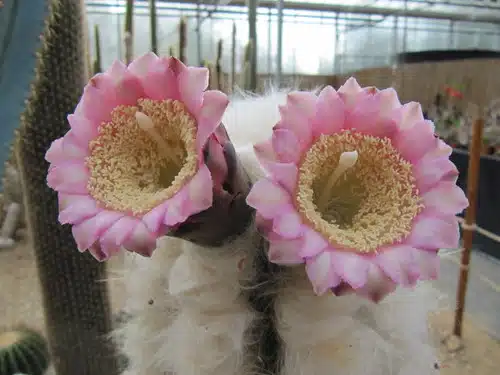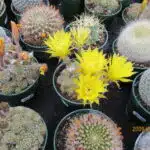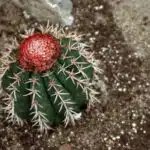Pilosocereus cacti are a genus of columnar cacti native to Central and South America. These plants are known for their unique appearance, with long spines and a cylindrical shape that can grow up to several meters tall. As members of the Cactaceae family, they require specific care to thrive in gardens or indoor environments.
Growing and caring for Pilosocereus cacti can be a fulfilling experience for horticulturists and botanists alike. With proper attention, these plants can live for decades and even bloom stunning flowers in the right conditions. In this article, we will discuss the essential elements required for healthy Pilosocereus growth, from soil type to watering schedules. Whether you’re an experienced gardener or new to the world of cacti, this guide will provide valuable insights on how to cultivate these fascinating plants successfully.
Understanding Pilosocereus Cacti
Pilosocereus cacti are fascinating plants that belong to the Cactaceae family. These unique cacti are characterized by their columnar shape and long, spiny stems. Some species can grow up to 30 feet tall, while others remain small and compact. Their growth habit is slow but steady, making them a great addition to any garden or indoor space.
One of the most notable characteristics of Pilosocereus cacti is their ability to store water in their stems. This allows them to survive in arid environments where other plants cannot thrive. The stems of these cacti are also covered in spines, which serve as protection against predators and harsh weather conditions.
When it comes to caring for Pilosocereus cacti, it’s important to remember that they prefer well-draining soil and plenty of sunlight. They also require minimal watering during the growing season, as overwatering can lead to root rot. With proper care and attention, these unique cacti can thrive for many years to come.
As we move forward into identifying different species of Pilosocereus cacti, it’s important to note that each species has its own unique characteristics and growth habits. By understanding these differences, we can better care for these fascinating plants and appreciate the diversity they bring to our gardens and indoor spaces.
Identifying Different Species
Understanding the Pilosocereus cacti is essential before identifying different species. These plants are native to tropical regions of Central and South America, where they grow in rocky areas and dry forests. Generally, they have long cylindrical stems that can reach up to 20 feet in height, and their stems can be ribbed or have tubercles.
Identification techniques for Pilosocereus cacti involve examining the plant’s distinguishing features. One way to differentiate between different species is by analyzing the stem’s size and shape. For example, some species have a more elongated stem than others, while some have a thicker stem with shorter ribs. Another way is to study the plant’s flowers, which bloom at night and often have white or pink petals. The fruit of some species is also edible.
It’s essential to identify different species of Pilosocereus cacti accurately because each one may require slightly different care instructions. Different species may thrive in varying light conditions or soil types; therefore, choosing the right environment for your plant is critical. In the next section, we will discuss how to choose the right soil for your Pilosocereus cactus and ensure it grows healthily for years to come.
Choosing The Right Soil
When selecting soil for growing pilosocereus cacti, the texture is an important factor to consider. A coarse soil that is well-draining is preferable, such as a sandy loam soil. Nutrients are also necessary for the growth of pilosocereus cacti; it is important to choose a soil that has sufficient levels of nitrogen, phosphorus and potassium. Finally, organic matter should also be added to the soil to provide additional nutrients and improve the texture.
Texture
When it comes to growing and caring for pilosocereus cacti, choosing the right soil is crucial. The texture of the soil plays a vital role in plant growth and development. The ideal soil for these cacti should be well-draining, porous, and have good aeration.
Growing techniques for pilosocereus cacti strongly depend on the type of soil used. The texture of the soil must allow water to drain freely, preventing root rot. These cacti thrive in sandy or rocky soils with gravel or perlite mixed in to increase drainage capacity. A well-draining soil also prevents moisture from accumulating around the roots, which can cause fungal infections.
In addition to its functional benefits, the texture of the soil can greatly enhance the visual appeal of pilosocereus cacti. Sandy soils provide a natural look that mimics their native habitats. Rocky soils offer an attractive contrast against the green color of these plants. Choosing a suitable soil texture not only promotes healthy growth but also adds to their aesthetic value.
Nutrients
Another crucial factor in growing and caring for pilosocereus cacti is providing them with the right nutrients. Nutrients are vital for plant growth and development, and their availability in the soil plays a significant role in determining the plant’s health. When it comes to choosing the right soil for these cacti, one must also consider the nutrient content of the soil.
The two main types of nutrients required by plants are organic and inorganic nutrients. Organic nutrients come from living organisms or their byproducts, while inorganic nutrients are minerals that have no carbon-hydrogen bonds. Both types of nutrients play important roles in plant growth, but organic nutrients provide more long-term benefits as they release slowly over time.
Maintaining a balance between these two types of nutrients is essential for healthy plant growth. Too much of one type can lead to an imbalance that can harm the plant’s overall health. The correct nutrient balance ensures proper absorption, transport, and utilization of essential elements needed by pilosocereus cacti for optimal growth and development. In summary, choosing the right soil texture and ensuring proper nutrient balance are crucial factors in ensuring healthy growth for pilosocereus cacti.
Providing Adequate Drainage
One common mistake in caring for pilosocereus cacti is not providing adequate drainage. This can lead to root rot and other fungal diseases, which can ultimately kill the plant. Some gardeners may argue that it is not necessary to provide drainage since cacti are adapted to arid environments, but this is a misconception. While these plants are drought-tolerant, they still require good drainage to prevent water from sitting in the soil and causing damage.
The importance of drainage cannot be overstated when it comes to growing pilosocereus cacti. A well-draining soil mix allows excess water to flow out of the pot or container, preventing the roots from becoming waterlogged. To achieve this, gardeners can use a variety of materials such as sand, gravel, perlite, or vermiculite in their soil mix. These materials create air pockets in the soil and improve water circulation, allowing the roots to breathe and absorb nutrients more efficiently.
When selecting a drainage material for pilosocereus cacti, it is important to choose one that is coarse enough to allow for good water flow but not so large that it interferes with root growth. Gardeners should also avoid using materials such as rocks or clay pebbles that can become compacted over time and reduce drainage capacity. By providing adequate drainage with appropriate materials, gardeners can ensure healthy growth and longevity for their pilosocereus cacti.
As we have seen, proper drainage is crucial for the health of pilosocereus cacti. However, it is only one aspect of their care requirements. In the next section, we will discuss watering and moisture requirements for these beautiful plants.
Watering And Moisture Requirements
Maintaining the proper moisture level is crucial in the growth and care of Pilosocereus cacti. Over watering is a common mistake that many beginners make, which can lead to root rot and ultimately kill the plant. It is important to let the soil dry completely before watering again. To prevent over watering, it is recommended to use well-draining soil and pots with drainage holes.
Controlling humidity levels can also aid in preventing over watering and promoting healthy growth. Pilosocereus cacti thrive in dry environments with low humidity levels, similar to their natural habitat. If grown indoors or in areas with high humidity, it is essential to provide adequate ventilation or a fan to improve air circulation around the plant.
To help maintain proper moisture levels, it is beneficial to create a watering schedule based on the specific needs of your plant. The frequency of watering will depend on various factors such as climate, pot size, and overall health of the plant. It is also recommended to avoid using cold water when watering as this can shock the roots and damage the plant.
| Watering Frequency | Soil Type | Pot Size |
|---|---|---|
| Every 2 weeks | Fast-draining soil mix | Small pot (up to 6 inches) |
| Every 3-4 weeks | Cactus soil mix | Medium pot (6-10 inches) |
| Every 4-6 weeks | Sandy soil mix | Large pot (over 10 inches) |
Incorporating these methods for over watering prevention and humidity control can ensure the success of your Pilosocereus cacti. By providing optimal growing conditions through proper moisture management, you can promote healthy growth and longevity for your plants. In the next section, we will discuss fertilization and nutrient needs for these unique plants.
Fertilization And Nutrient Needs
- Pilosocereus cacti can benefit from fertilization, but should be fertilized only sparingly.
- Generally, a balanced fertilizer, such as 10-10-10, should be used, as this provides the cacti with the necessary nutrients it needs.
- Fertilization should be done during the spring and summer months, as this is when the cacti is actively growing.
- Nitrogen is the most important nutrient for cacti, as this helps promote proper growth of foliage.
- Phosphorus should also be present in the fertilizer, as this helps the cacti develop strong roots.
- Potassium should also be present in the fertilizer, as this helps promote flowering and overall health of the cacti.
Fertilizer Types
As a horticulturist, the decision of whether to use organic or synthetic fertilizers for pilosocereus cacti can be a difficult one. Organic fertilizers are derived from plant or animal matter and often contain beneficial microorganisms that can improve soil health. Meanwhile, synthetic fertilizers are made from chemicals and minerals and provide nutrients in precise amounts to promote rapid growth. Ultimately, the choice between the two will depend on personal preference and the specific needs of your cactus.
When it comes to frequency of fertilization, it is important to remember that less is often more. Over-fertilizing can lead to nutrient burn, which can cause irreversible damage to your cactus. As a general rule of thumb, pilosocereus cacti should only be fertilized during their growing season (typically spring and summer) and should not receive any fertilizer during the dormant season (fall and winter). Additionally, it is recommended to dilute fertilizer at half-strength before application.
In conclusion, choosing the right type of fertilizer and frequency of application is crucial for the healthy growth and development of pilosocereus cacti. By understanding the benefits and drawbacks of organic vs. synthetic fertilizers as well as properly timing applications throughout the year, you can help ensure that your cactus thrives in its environment. Remember: always err on the side of caution when it comes to fertilization – too much fertilizer can do more harm than good!
Time Of Fertilization
As a horticulturist or botanist, understanding the best time to fertilize pilosocereus cacti is crucial to ensure healthy growth and development. It is important to note that these cacti should only be fertilized during their growing season, which typically occurs in the spring and summer months. During this period, pilosocereus cacti are actively growing and require additional nutrients to thrive.
When it comes to the types of fertilizers used during the growing season, both organic and synthetic options can be effective. Organic fertilizers are derived from plant or animal matter and often contain beneficial microorganisms that improve soil health. Meanwhile, synthetic fertilizers are made from chemicals and minerals that provide precise amounts of nutrients for rapid growth. Regardless of which type is chosen, it’s important not to over-fertilize as nutrient burn can cause irreversible damage.
To ensure proper application, dilute fertilizer at half-strength before applying it to your pilosocereus cactus during the growing season. This will help prevent any potential harm caused by over-fertilization. Additionally, avoid fertilizing during the dormant season (typically fall and winter) as pilosocereus cacti require less nutrients during this period. Remembering these guidelines will help ensure your cactus receives the right amount of nutrients at the best time for optimal growth and health.
Nutrient Requirements
In addition to understanding the best time to fertilize pilosocereus cacti, it is equally important for horticulturists and botanists to be knowledgeable about their nutrient requirements. Indoor cultivation of these cacti can present challenges since they are native to arid climates with well-draining soil. Therefore, ensuring that the soil pH levels are suitable for optimal nutrient absorption is crucial.
Pilosocereus cacti have specific nutrient requirements that must be met for optimal growth and health. These requirements include nitrogen, phosphorus, and potassium (NPK), as well as trace elements such as magnesium, iron, and calcium. It is important to note that over-fertilization can cause nutrient burn, which can lead to irreversible damage. As a result, careful consideration should be given when choosing a fertilizer and how much is applied.
To ensure proper nutrient uptake, it is recommended to test the soil pH levels regularly. Pilosocereus cacti thrive in slightly acidic soil with a pH range between 5.5-6.5. If the pH levels are too high or too low, this can limit the plant’s ability to absorb nutrients properly. To adjust the pH levels, adding organic matter or sulfur can help lower pH levels while limestone or wood ash can raise them if needed. By monitoring and adjusting soil pH levels accordingly, horticulturists and botanists can help ensure that their pilosocereus cacti receive the necessary nutrients for healthy growth and development.
Temperature And Light Preferences
Imagine a beautiful desert landscape, with the sun beating down and the temperature rising. This is the natural habitat of pilosocereus cacti, which thrive in hot, dry climates with plenty of sunlight. To maximize growth and enhance their aesthetics, it is important to provide these cacti with similar environmental conditions.
In terms of temperature preferences, pilosocereus cacti prefer warm temperatures ranging from 70-90°F during the day and around 60-70°F at night. They can tolerate higher temperatures up to 100°F during the day for short periods of time but may suffer damage if exposed to prolonged high temperatures. On the other hand, they are sensitive to frost and should not be exposed to temperatures below 40°F.
When it comes to light preferences, pilosocereus cacti require full sun exposure for maximized growth and healthy development. Direct sunlight for at least six hours a day is recommended for optimal growth. However, if grown indoors or in shaded areas outdoors, they may still survive but may not grow as quickly or produce flowers as readily.
To ensure that your pilosocereus cacti receive the necessary warmth and sunlight for optimal growth and visual appeal, consider providing them with a warm location with plenty of direct sunlight exposure. In doing so, you will be rewarded with lush greenery and beautiful blooms from these hardy desert plants. Next, we will explore pruning and shaping techniques that can help maintain their beauty and health over time.
Pruning And Shaping Techniques
Pilosocereus cacti are known for their unique and striking appearance, making them a popular addition to many gardens and indoor spaces. While temperature and light preferences play a crucial role in the plant’s growth, it is also essential to consider pruning and shaping techniques to maintain its health and beauty. Proper pruning can encourage new growth, while shaping can help control the direction of the plant’s growth.
Wire techniques can be used in shaping pilosocereus cacti by attaching wire to the stem and gently bending it into the desired shape. This method should be done carefully as too much pressure can damage or break the stem. Decorative containers can also enhance the plant’s aesthetic appeal while providing proper drainage for healthy growth. When selecting a container, make sure it is large enough for the plant’s roots and leaves room for future growth.
While pilosocereus cacti are relatively low maintenance, pests and diseases can still pose a threat to their health. Common pests include spider mites, mealybugs, and scale insects. These pests can be controlled with insecticidal soap or neem oil. Diseases such as root rot can occur due to overwatering or poor drainage. To prevent this, make sure the soil is well-draining and allow it to dry out between waterings. Regular inspection of the plant will help identify any issues early on, allowing for prompt treatment and prevention of further damage.
Dealing With Pests And Diseases
- Identification of pests and diseases in Pilosocereus cacti can be challenging due to their varied morphological characteristics.
- Common symptoms that can be observed in Pilosocereus cacti include yellowing of leaves and wilting of branches.
- Treatment of pests and diseases in Pilosocereus cacti is largely dependent on accurate identification of the causal factor.
- Cultural practices such as proper pruning and fertilization, as well as chemical treatments, can be used to manage pests and diseases in Pilosocereus cacti.
Identifying Pests And Diseases
Preventing infestations and identifying pests and diseases early are key to maintaining the health of your pilosocereus cacti. Some common pests that can affect these cacti include spider mites, mealybugs, and scale insects. Spider mites can cause yellowing or browning of leaves while mealybugs and scale insects can cause a white, cotton-like substance on the plant. To prevent infestations, regularly inspect your plant for any signs of pests and keep it clean by removing any dead or decaying material.
If you do identify pests on your pilosocereus cactus, there are natural remedies for treatment that you can try before resorting to chemical pesticides. For example, you can use a mixture of water and dish soap to spray on infected areas. This will help suffocate the pests without harming the plant. Another option is to introduce natural predators such as ladybugs or lacewings to the area where the cactus is growing. These beneficial insects will eat the harmful pests and help control their population.
In addition to pests, pilosocereus cacti are also susceptible to diseases such as root rot caused by overwatering or fungal infections from high humidity levels. To prevent these issues, make sure to only water when the top inch of soil is dry and avoid getting water on the leaves or stem of the plant. If you do notice signs of disease such as brown spots or wilting leaves, remove any affected areas immediately to prevent further spread. By taking preventative measures and treating issues early with natural remedies, you can ensure your pilosocereus cacti stay healthy and thrive in their environment.
Treating Pests And Diseases
Preventing infestations and diseases is crucial to maintaining the health of your pilosocereus cacti. However, sometimes it can be challenging to avoid these issues entirely. When pests or diseases do occur, it is essential to take swift action to prevent them from spreading and causing further damage.
Treating pests and diseases in pilosocereus cacti can be done using natural remedies before resorting to chemical pesticides. For instance, a mixture of water and dish soap can help suffocate pests without harming the plant. Introducing natural predators such as ladybugs or lacewings can also help control harmful pest populations. It is essential to ensure that any treatments used are safe for both the plant and the environment.
When dealing with a disease-infected pilosocereus cactus, quick diagnosis and treatment are necessary to prevent further spread. Remove any diseased parts immediately and avoid overwatering the plant, which can cause root rot. Increasing ventilation or decreasing humidity levels around the plant can also help prevent fungal infections caused by high humidity levels. By being proactive in preventing infestations and treating issues early with natural remedies or other appropriate methods, you can ensure your pilosocereus cacti remain healthy and thrive in their environment.
Propagation Methods
Pilosocereus cacti can be propagated through cutting or seed propagation methods. Cutting propagation involves using a sharp, sterilized knife to cut a section of the stem from the parent plant. The cutting should be left to dry for a week before being planted in well-draining soil. It is important to keep the soil moist, but not waterlogged, during the rooting process. After several weeks, new growth should appear from the cutting, indicating successful propagation.
Seed propagation is another method of propagating Pilosocereus cacti. To begin seed propagation, collect mature fruits from the parent plant and extract the seeds. The seeds should then be soaked in water for several hours to soften their outer coating before planting them in well-draining soil. Water regularly and keep the soil slightly moist until germination occurs.
Table: Comparison of Cutting Propagation and Seed Propagation Methods
| Criteria | Cutting Propagation | Seed Propagation |
|---|---|---|
| Time to Germination | Faster | Slower |
| Success Rate | Higher | Lower |
| Plant Size | Same as Parent Plant | May Vary |
| Maintenance Requirements | Low | Moderate |
| Cost | Low | High |
Propagation methods are crucial for ensuring that your Pilosocereus cacti thrive and propagate successfully. Choosing between cutting and seed propagation depends on factors such as time constraints, success rate expectations, plant size goals, maintenance requirements, and cost considerations. Careful consideration of these factors will help you determine which method is best suited for your needs and preferences. In the next section, we will discuss transplanting and repotting tips that will help you maintain healthy plants while they grow over time.
Transplanting And Repotting Tips
As we have learned in the previous section, pilosocereus cacti can be propagated through various methods. Now, let us discuss how to ensure their growth and longevity through proper transplanting and repotting techniques.
Repotting frequency is essential in maintaining a healthy pilosocereus cactus. As these plants grow at a moderate pace, they require repotting every two to three years. However, if you notice that the roots are protruding from the drainage hole or if the soil has become too compacted, it is best to transfer them to a new pot immediately.
Pot selection is also critical in ensuring your pilosocereus cactus thrives. Always choose a well-draining container with ample drainage holes as moisture retention can lead to root rot. You may opt for clay pots as they allow for better air circulation or plastic containers that retain moisture longer. Remember to select a pot size that accommodates the plant’s growth and provides enough space for its roots to expand.
As we have seen, transplanting and repotting are crucial aspects of growing healthy pilosocereus cacti. By following these simple tips on repotting frequency and pot selection, you can ensure your plant’s longevity and health. In the next section, we will discuss how best to display these stunning cacti in your home or garden without compromising their well-being.
Displaying Pilosocereus Cacti
Displaying Pilosocereus cacti is an excellent way to showcase their unique features and beauty. Creating arrangements with other succulent plants can provide a stunning visual display that highlights the cactus’s unusual growth patterns and striking appearance. When selecting containers, it is essential to choose ones with proper drainage holes to prevent waterlogging, which can cause root rot.
One popular way of displaying Pilosocereus cacti is by creating a rock garden. To achieve this effect, arrange the plants in groups and place them on top of stones or rocks of different sizes. This will create a visually appealing landscape that mimics the cactus’s natural habitat.
Another way to display these beautiful plants is by arranging them in hanging baskets or terrariums. These containers provide an opportunity to showcase the cactus’s long, trailing stems while keeping them safe from accidental damage or breakage.
Creating arrangements and selecting containers are essential aspects of displaying Pilosocereus cacti. By using different combinations of plants and containers, you can create unique displays that capture the plant’s beauty and enhance your living space. In the next section, we will discuss common mistakes to avoid when caring for your Pilosocereus cacti.
Common Mistakes To Avoid
Just like any other plant, pilosocereus cacti need proper care and attention to thrive. While displaying your pilosocereus cacti may add aesthetic value to your home, you must ensure that it receives the care it needs. In this section, we will discuss some common mistakes to avoid when caring for your pilosocereus cacti.
One of the most common mistakes people make is overwatering their cacti. Pilosocereus cacti are drought-resistant plants that can survive in harsh environmental conditions. Therefore, they do not require frequent watering. Overwatering can lead to root rot and other diseases that may cause your plant’s death. To prevent overwatering, you should only water your pilosocereus cacti when the soil is dry.
Proper lighting techniques are also essential for growing healthy pilosocereus cacti. These plants require bright sunlight to grow optimally. However, direct sunlight can scorch the leaves and damage the plant. Therefore, you should provide filtered or indirect light for about six hours a day. You can place your pilosocereus cactus near a south-facing window or use fluorescent lights to provide artificial light if natural light is inadequate.
As a horticulturist or botanist, preventing overwatering and using proper lighting techniques are crucial for growing healthy pilosocereus cacti. By avoiding these common mistakes, you will ensure that your plant thrives and remains healthy for years to come. However, even with proper care, problems may arise from time to time, which we will address in our next section on troubleshooting problems faced when caring for your pilosocereus cactus.
Troubleshooting Problems
Common mistakes can occur during the care and growth of Pilosocereus cacti. One mistake is overwatering, which can lead to root rot and ultimately kill the plant. Another common mistake is not providing enough sunlight, as these cacti require ample amounts of light to grow properly. Additionally, using the wrong type of soil or pot size can hinder growth and lead to root-bound plants.
To prevent overwatering, it is important to allow the soil to dry out completely between watering sessions. This may mean reducing watering frequency during cooler months or adjusting your watering schedule based on your specific climate conditions. Providing adequate sunlight also requires some attention, as these cacti prefer bright indirect light but should be protected from direct afternoon sun.
To avoid issues with soil or pot size, use a well-draining mix specifically formulated for cacti and succulents. Ensure that the pot has drainage holes and is only slightly larger than the plant’s root system. This will help prevent waterlogging and ensure proper nutrient uptake by the roots.
By following these prevention tips, you can avoid common mistakes when caring for Pilosocereus cacti and enjoy healthy, thriving plants in your home or garden. In the next section, we will discuss tips for enjoying your beautiful plants once they have reached maturity.
Enjoying Your Beautiful Plants
If you have followed the previous section’s guidelines on how to troubleshoot problems with your pilosocereus cacti, then you are well on your way to enjoying beautiful plants in your home or garden. Now, let us focus on how to create a relaxing atmosphere by incorporating these cacti into your home decor.
Firstly, you can use pilosocereus cacti as centerpieces for your dining or coffee tables. The tall and slender stems of these cacti make them perfect for adding height to any arrangement. You could also group several different types of cacti together in a terrarium or planter, creating a visually stunning display that will add interest and texture to any room.
Secondly, placing pilosocereus cacti in rooms where you spend most of your time can help create a calming ambiance. Research has shown that plants and nature have a positive impact on our mental health and wellbeing. Therefore, having a few potted cacti around can help reduce stress levels and improve air quality.
Overall, growing and caring for pilosocereus cacti is an enjoyable experience that can not only add beauty to your home but also improve your overall wellbeing. By incorporating these plants into your home decor, you can create an inviting and tranquil environment where you can relax and unwind after a long day.
Frequently Asked Questions
Can Pilosocereus Cacti Grow Indoors Or Do They Need To Be Outside?
Pilosocereus cacti can be grown both indoors and outdoors, depending on the specific needs of the plant. For optimal growth, it is important to consider factors such as light, temperature, and humidity. While outdoor planting can provide ample sunlight and fresh air, indoor cultivation may require supplemental lighting and controlled temperatures. Additionally, container planting can offer more control over soil moisture and nutrients compared to ground planting. As a horticulturist or botanist, it is important to weigh the pros and cons of each approach before determining the best method for growing pilosocereus cacti. Ultimately, it is essential to prioritize the health and well-being of the plant in order to achieve successful growth and care.
How Often Should I Prune My Pilosocereus Cactus And What Tools Should I Use?
Pruning frequency and cutting tools are important aspects to consider when caring for pilosocereus cacti. It is recommended to prune the cactus once a year to remove any dead or diseased stems, as well as to promote new growth. The best tools to use for pruning are sharp, clean shears or scissors. Additionally, soil requirements and watering schedule play a vital role in the health of these cacti. Pilosocereus cacti thrive in well-draining soil that is slightly acidic with a pH of 6.0-6.5. As for water, it is important to water moderately during the growing season and reduce watering during the dormant period. Overall, proper pruning techniques, together with suitable soil conditions and watering schedules, are crucial for maintaining healthy pilosocereus cacti that will thrive in both indoor and outdoor environments.
Are There Any Specific Pests Or Diseases That Commonly Affect Pilosocereus Cacti?
As with any plant, pilosocereus cacti are susceptible to various pests and diseases that can negatively impact their growth and overall health. Common pests that may affect these cacti include spider mites, mealybugs, and scale insects. Treatment options for these pests include using insecticidal soap or oil sprays, removing affected areas, or introducing natural predators like ladybugs or lacewings. To prevent diseases from affecting your pilosocereus cactus, it is essential to provide proper care by ensuring adequate sunlight exposure, avoiding overwatering, and maintaining good soil drainage. In general, keeping an eye out for signs of pest infestations or disease symptoms and taking action promptly can help keep your pilosocereus cacti healthy and thriving.
How Long Does It Take For A Pilosocereus Cactus To Reach Maturity And Start Producing Flowers?
Pilosocereus cacti are known for their long, slender stems and attractive flowers that bloom in various shades of pink, red, and white. The time it takes for a pilosocereus cactus to reach maturity and start producing flowers varies depending on several factors such as growing conditions and flowering factors. Generally, these cacti require optimal growing conditions such as well-drained soil, full sun exposure, and moderate watering to thrive. Additionally, adequate fertilization during the growing season can significantly enhance the growth rate of the plant. Flowering factors such as temperature fluctuations, light intensity, and humidity levels also play a crucial role in determining when a pilosocereus cactus starts to flower. Under ideal conditions, it may take between 3-5 years for a pilosocereus cactus to reach maturity and begin producing beautiful flowers that add aesthetic value to any garden or home décor.
Is It Possible To Transplant A Pilosocereus Cactus That Is Too Large For Its Pot Or Should I Just Repot It?
When considering the options of transplanting or repotting a pilosocereus cactus that has outgrown its current container, it is important to first assess the size of the pot that will accommodate its growing needs. If the current pot is too small, repotting may not suffice as a solution, and in such cases, transplantation may be necessary. It is essential to consider this decision carefully as it can impact the health of your plant. Transplantation involves removing the plant from its current location and transferring it to a new spot with fresh soil, while repotting entails only replacing the old soil with new soil in the same container. Pot size selection is crucial when transplanting because selecting too large of a pot can lead to overwatering and root rot, while selecting too small of one can stunt growth and cause overcrowding. Therefore, it is wise to select a pot that offers adequate room for both root development and water drainage. A hypothetical scenario could be if a pilosocereus cactus has outgrown its container by 50% or more; in such instances, transplantation would be the best option for ensuring continued healthy growth.
Conclusion
Pilosocereus cacti are a beautiful addition to any garden or indoor space. These cacti can be grown both indoors and outdoors, but it is important to provide them with adequate sunlight and well-draining soil. Pruning should be done sparingly, using clean and sharp tools to avoid damaging the plant.
Pests and diseases can be a concern for Pilosocereus cacti, with common issues including mealybugs and root rot. Regular inspections and proper care can help prevent these problems from arising. It typically takes several years for a Pilosocereus cactus to reach maturity and produce flowers, but patience will ultimately lead to a stunning display of blooms.
One potential objection may be the level of maintenance required for these plants. While Pilosocereus cacti do require some attention, they are relatively low maintenance compared to many other plants. With proper care, they can thrive in various environments and add beauty to any space. As horticulturists or botanists, we recommend giving these unique cacti a try in your next gardening project.
Image Credits
- “Pilosocereus leucocephalus” by wallygrom (featured)





























